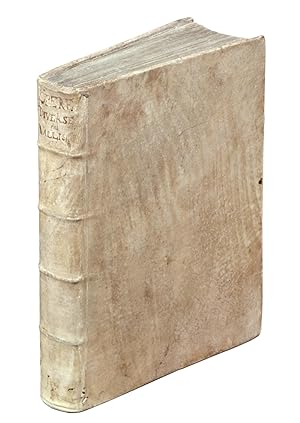Vallisneri Antonio 1661 1730 (1 results)
Product Type
- All Product Types
- Books (1)
- Magazines & Periodicals
- Comics
- Sheet Music
- Art, Prints & Posters
- Photographs
- Maps
-
Manuscripts &
Paper Collectibles
Condition
- All Conditions
- New
- Used
Binding
- All Bindings
- Hardcover
- Softcover
Collectible Attributes
- First Edition
- Signed
- Dust Jacket
- Seller-Supplied Images
- Not Printed On Demand
Seller Location
Seller Rating
-
Opere diverse. cioe: I. Istoria del Camaleonte Affricano, e di varj Animali d'Italia. II. Lezione Accademica intorno all'Origine delle Fontane. III. Raccolta di varj Trattati accresciuti con Annotazioni, e con Giunte
Published by Venice Giovanni Gabriele Hertz 1715, 1715
Three parts in one volume, 4° (231x156mm). [12, including frontispiece], 200; [8], 87, [1]; [4], 261, [3] pages; complete with the last blank leaf. Engraved author's portrait as a frontispiece. Thirty engraved folding plates. Contemporary vellum, ink title on the spine. Marbled edges. A very good copy, pale waterstains to the lower outer margin, small wormholes to the gutter of a few leaves, without any loss.Provenance: Antonio Vallisneri, given as a gift by him to the Italian scholar and historian Francesco Saverio Quadrio (1695-1756; see Vallisneri's dedication on the recto of the first leaf, 'All'Illmo P.R.D. Francesco Xauerio Quadrio della Comp.a di Gesł L'Authore in segno de riuerentiss.ma Stima, e di eterne obbligazioni'). First edition of this collection of Vallisneri's writings on natural history, offered here in a fine copy gifted by him to the renowned Italian historian Francesco Saverio Quadrio, who is especially well-known for his Della storia e della ragione di ogni poesia, a voluminous history of poetry, theatre, and music. Antonio Vallisneri was born at Trassilico, in Garfagnana, on 3 May 1661. His education initially followed the traditional path of the Jesuit schools – a path reserved for the sons of the 'best' families of the day. In 1682, he started attending Bologna University, where he became one of Malpighi's students. In 1685, he was awarded a degree from the College of Reggio (Emilia), after which he extended his practical knowledge and experience in Venice, Padua and Parma. He subsequently returned to his homeland, where he practised his profession and simultaneously initiated an extremely intense period of natural history studies. Vallisneri's works and observations evince an original interpretation of the themes and perspectives of the Galileian medical tradition followed by Malpighi and Redi and were positioned along the most advanced front of the debates between natural history and life science that were then under way in Europe. Vallisneri was inclined to set his scientific hypotheses within a general theoretical framework although maintained a Baconian respect for empirical data, and he committed himself to overcoming the limits of Cartesian dualism and mechanism, first with reference to Malebranchian thought and then to that of Leibniz. His teachings were based on his meticulous observations of natural science, particularly in the fields of entomology and comparative anatomy; he was convinced that scientific knowledge is best acquired through experience and reasoning, and this principle was followed in his anatomical dissections and carefully drawn descriptions of insects. Vallisneri's research into reproduction demonstrated the non-existence of spontaneous generation and anticipated evolutionist theory. In the collection presented here the Lezione Accademica intorno all'Origine delle Fontane is especially noteworthy. The lucidity of Vallisneri's experimental approach makes it a perfect example of the Galileian method.Garrison-Morton, 302; Pritzel 9675; M. Sabia, Le opere di Antonio Vallisneri medico e naturalista reggiano (1661-1730). Bibliografia ragionata, Rimini 1996, pp. 106-120; Philobiblon, One Thousand Years of Bibliophily, no. 224. Book.


